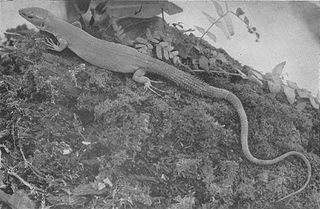
Agamidae is a family of over 300 species of iguanian lizards indigenous to Africa, Asia, Australia, and a few in Southern Europe. Many species are commonly called dragons or dragon lizards.

Draco is a genus of agamid lizards that are also known as flying lizards, flying dragons or gliding lizards. These lizards are capable of gliding flight via membranes that may be extended to create wings (patagia), formed by an enlarged set of ribs. They are arboreal insectivores.

Gastropholis is a genus of Equatorial African lacertid lizards of the family Lacertidae which is distributed in southern Liberia, Ivory Coast and Ghana, western Cameroon, Equatorial Guinea, Democratic Republic of Congo, eastern Kenya, Tanzania and south to northeastern Mozambique.

Draco dussumieri, also known as the Indian flying lizard, Western Ghats flying lizard, or southern flying lizard, is a species of agamid lizard capable of gliding from tree to tree. It is found principally in the Western Ghats and some other hill forests of Southern India. They are almost completely arboreal, found on trees in forests and adjoining palm plantations where they climb trees to forage for insects and glide to adjoining trees by expanding the patagium, loose skin on the sides of the body which are supported by elongated ribs to act as wings. The skin on the sides of the neck are also extended to the sides using the hyoid bones of the tongue to support them. During the breeding season males maintain small territories which they defend from other males while courting females. Males have a more colourful patagium than females and they prominently extend their yellow dewlaps forward in display. Although living almost their entire lives on the trees, females descend to the ground to lay eggs in soil. This is the species with the westernmost distribution within the genus Draco, the majority of species occurring in Southeast Asia.
Japalura andersoniana, Anderson's mountain lizard, is a species of lizard in the family Agamidae. The species is native to southern Asia.

Japalura tricarinata is a species of agamid lizard endemic to Asia.
Dasia nicobarensis, the Nicobar tree skink or Nicobar dasia, is a species of arboreal skink found in the Nicobar Islands of India.

The Dominican ground lizard or Dominican ameiva is a species of lizard. It is endemic to the Caribbean island of Dominica, an island noted for its intact and abundant reptile population, where it is most commonly found in dry coastal woodland.
Takydromus toyamai, also known commonly as the Miyako grass lizard, is a species of lizard in the family Lacertidae. The species is endemic to the Ryukyu Islands.

Diploderma swinhonis, also known commonly as the Taiwan japalure, Swinhoe's japalure, Swinhoe's lizard, and Swinhoe's tree lizard, is a species of lizard in the family Agamidae. The species is native to Taiwan. It is considered an invasive alien species in Japan after likely being transported from Taiwan by humans. A foraging ambush predator, this lizard preys primarily on arthropods and thus remains at the bottom of forests perched on trees where sunlight is present. Diploderma swinhonis is not a major threat to humans and is able to adapt to a variety of habitats, including urban environments. Male Diploderma swinhonis are physically distinct from females, with their body sizes being much larger and having a yellow stripe. These lizards sexually reproduce on a seasonal basis and hibernate during the winter time.
The short-legged japalure is a species of lizard endemic to Taiwan. It is found in mountains at elevations of 1100 to 2200 m and inhabits forest edges. It has a 10-cm long body, and the total length reaches 25 cm. It is sexually dimorphic. The male has a black back, with yellow-green spots and stripes. The female is mainly green. A diurnal and oviparous species, it eats insects and other small invertebrates. The species was described by J. Linsley Gressitt in 1936. It is listed as other conservation-deserving wildlife in the Taiwan Wildlife Conservation Act. This lizard is closely related to Diploderma swinhonis
Diploderma luei is a species of lizard in the family Agamidae. The species is endemic to Taiwan.
The banded japalure is a species of lizard. It is found in northern Vietnam and Sichuan, Chongqing, Guizhou and Guangxi of China, at elevations of 800–2,000 m (2,600–6,600 ft). Its habitat is montane forests. Its snout-vent length is 7.5 cm (3.0 in). The IUCN Red List of Threatened Species has assessed the species to be of least concern.

Ota's mountain lizard is a species of lizard in the family Agamidae. The species is native to Southern Asia.
Diploderma zhaoermii is a species of lizard in the family Agamidae. The species is endemic to Sichuan, China.
Calotes bhutanensis is a species of lizard in the family Agamidae. It is endemic to the mountainous regions of Bhutan.
Cristidorsa is a genus of lizards in the family Agamidae native to India and Myanmar. The name Cristidorsa is Latin for "ridged dorsum", in reference to the ridges on the backs of lizards in this genus. The common name ridged dragons was suggested by the authors of the 2018 genus description. The species were originally placed in the genus Japalura.

Diploderma is a genus of lizards in the family Agamidae. Species of Diploderma are native to Myanmar, China, Vietnam, Taiwan, and Japan. Most of the species are found in China, including many endemics.










